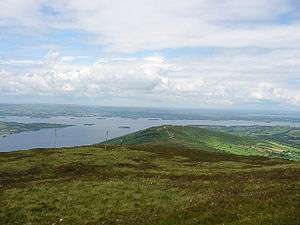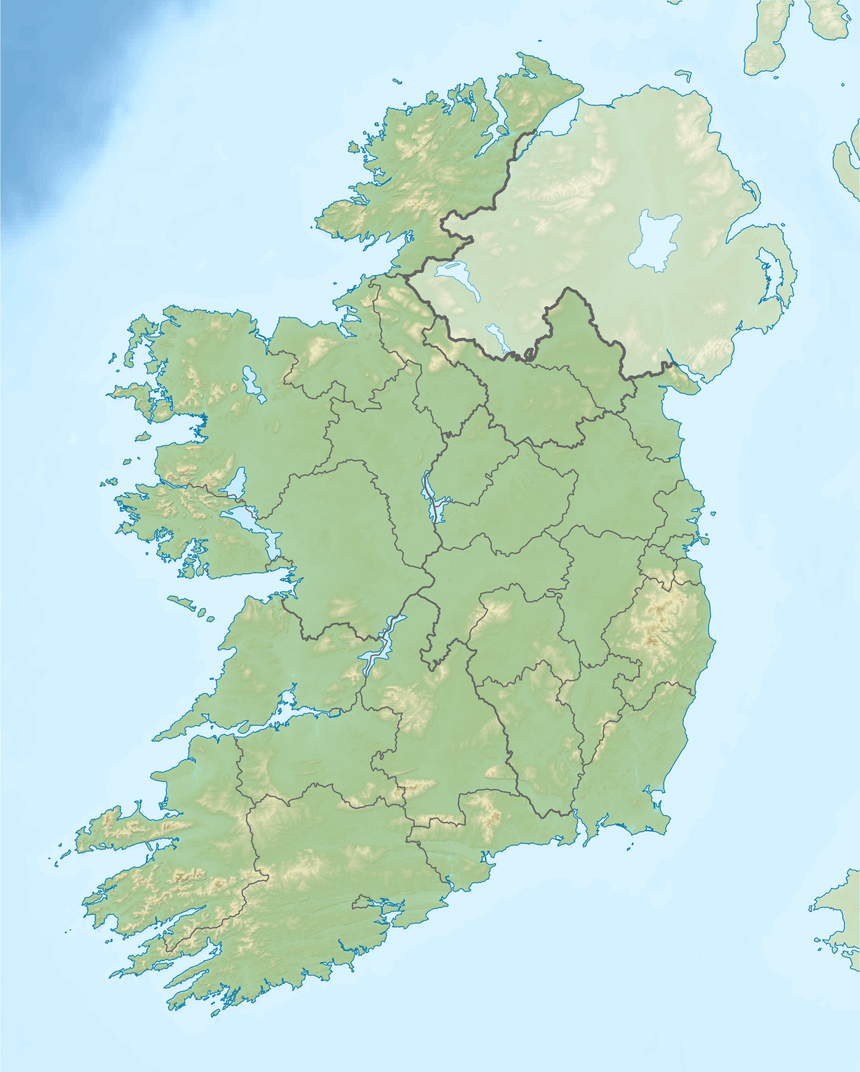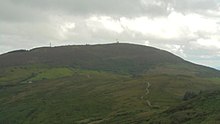Arra Mountains
The Arra Mountains or Arra Hills (Irish: Sliabh an Ara)[1] are situated in County Tipperary in Ireland, between the towns of Nenagh and Ballina, south east of Lough Derg (Shannon) and north of the M7 Motorway.
| Arra Mountains | |
|---|---|
| Irish: Sliabh an Ara | |
 Lough Derg from Arra Mountains | |
| Highest point | |
| Peak | Tountinna |
| Elevation | 457 m (1,499 ft) |
| Geography | |
 | |
| Country | Republic of Ireland |
| Province | Munster |
| Range coordinates | 52°50′N 8°22′W |
The highest summit is Tountinna (Irish: Tonn Toinne) at 457m high.[2]
On Loughtea Hill, south-west of Portroe, a 20-metre-high (66 ft) stainless steel cross was erected in 2002 to mark the millennium and to replace an original cross placed there following the Eucharistic Congress of Dublin (1932).[3]
Fintan's Grave a cave on Tountinna where in mythology Fintan mac Bóchra is said to have waited out the flood here.[4]
Description
Tountinna, the highest peak, does not qualify as a mountain using the usual convention whereby a mountain is defined (in Ireland and the UK) as any summit at least 2,000 ft (610 m) high,[5][6][7][8][9] whilst the official UK government's definition of a mountain is a summit of 600 metres or higher.[10] In addition, some definitions also include a topographical prominence requirement, typically 100 feet (30 m) or 500 feet (152 m).[7] In practice, mountains in Scotland are frequently referred to as "hills" no matter what their height, as reflected in names such as the Cuillin Hills and the Torridon Hills. In Wales, the distinction is more a term of land use and appearance and has nothing to do with height. For a while, the US defined a mountain as being 1,000 feet (304.8 m) or more tall. Any similar landform lower than this height was considered a hill. However, today, the United States Geological Survey (USGS) concludes that these terms do not have technical definitions in the US.[11] However both the Placenames Database of Ireland and the Ordnance Survey of Ireland refer to the Arra range as mountains, not hills.[1][12]
There are a few loop walks on and around Tountinna going through Killary Glen and past Black Lough. The Lough Derg Way passes through Laghtea Hill and Tountinna.
There is a small valley called Killary Glen southwest of Tountinna
List of Hills
- Tountinna, Tonn Toinne 457m
- Loughtea, Cnoc Leacht Aodha 320m
- Corbally Hill, Cnoc an Chorrbhaile 339m
- Coum Hill, Cnoc an Choim 330m

References
- "Sliabh Ara / Arra Mountains". Bunachar Logainmneacha na hÉireann - Placenames Database of Ireland. Retrieved 14 December 2019.
- Ordnance Survey of ireland Discovery series map 59 3rd edition (2011)
- "Lough Derg Way". EveryTrail. Retrieved 21 May 2013.
- R. A. S. Macalister, ed. (1941). "§26-38: The Invasions of Cessair and of Partholon". Lebor Gabála Érenn: Book of the Taking of Ireland. Dublin: Irish Texts Society. p. §28.
- Nuttall, John & Anne (2008). The Mountains of England & Wales - Volume 2: England (3rd ed.). Milnthorpe, Cumbria: Cicerone. ISBN 1-85284-037-4.
- "Survey turns hill into a mountain". BBC News. 19 September 2008. Retrieved 3 February 2013.
- A Mountain is a Mountain - isn't it? at www.go4awalk.com. Accessed on 3 Feb 2013.
- mountain at dictionary.reference.com. Accessed on 3 Feb 2013.
- Wilson, Peter (2001). ‘’Listing the Irish hills and mountains’’ in ‘’Irish Geography’’, Vol 34(1), University of Ulster, Coleraine, p. 89.
- What is a “Mountain”? Mynydd Graig Goch and all that… Archived 30 March 2013 at the Wayback Machine at Metric Views. Accessed on 3 Feb 2013.
- What is the Difference Between a Mountain and a Hill? at www.wisegeek.com. Accessed on 3 Feb 2013.
- "Shop.osi.ie Mapviewer". Maps.osi.ie. Archived from the original on 29 August 2012. Retrieved 21 May 2013.